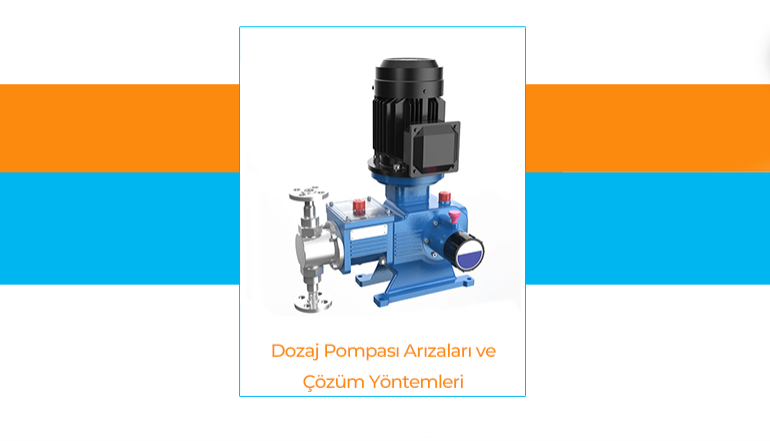- sisdoz@sisdoz.com.tr
- TR
Blog
- Home
- Sisdoz Blog
- Dosing Pump Failures and Solutions

In industrial processes, precise dosing is critical for production quality and process safety. However, even the highest-quality dosing pumps can show signs of failure over time. Whether used in a chemical plant or a water treatment line, unexpected pump failures can negatively impact production continuity.
In this article, we detail the most common dosing pump failures and effective solutions.
1. Common Causes of Dosing Pump Failures
A dosing pump is constantly exposed to harsh conditions such as pressure, chemical attack, and mechanical wear.
The most common causes of failure are:
• Incorrect material selection (chemical incompatibility)
• Inadequate maintenance and cleaning
• Incorrect pressure/flow setting
• Worn seals or diaphragms
• Electrical problems
Knowing these factors will help you perform preventative maintenance before problems occur.
2. Low Flow Rate and Flow Problems
Symptom: The pump cannot transfer sufficient fluid.
Possible Causes:
• Suction line blockage
• Air bubble formation
• Worn or ruptured diaphragm
Solutions:
• Clean the suction line and check the filters.
• Bleed the system and restart it.
• Replace worn parts with original spare parts.
3. Pressure Loss Problems
Symptom: The pump operates, but the outlet pressure is low.
Possible Causes:
• Leak in the pressure line
• Outlet valve blockage
• Diaphragm damage
Solutions:
• Check the connections with a leak detector or a simple soap test.
• Clean or replace the clogged outlet valve.
• Replace the damaged diaphragm according to the manufacturer's recommendations.
4. Pump Does Not Start or Is Difficult to Start
Symptom: The pump does not start or is difficult to start.
Possible Causes:
• Power supply error
• Motor failure
• Low air line pressure in pneumatic pumps
Solution Methods:
• Check electrical connections and fuses.
• Test the motor with a multimeter and have it serviced if necessary.
• Adjust the air pressure in pneumatic systems according to the manufacturer's recommendations.
5. Chemical Leaks and Leaks
Symptom: Fluid accumulation in the pump casing or connection points.
Possible Causes:
• Worn seals
• Loose fasteners
• Cracks in the casing
Solution Methods:
• Replace seals regularly.
• Tighten all connections with a torque wrench.
• If there are cracks in the casing, replace the part for safety rather than repair.
6. Increased Noise and Vibration
Symptom: Higher than normal noise and vibration occur.
Possible Causes:
• Air lock
• Loose pump feet
• Worn bearings
Solution Methods:
• Vent the system and start it.
• Secure the pump mounting.
• Check the bearings and replace if necessary.
7. Loss of Dosing Accuracy
Symptom: A difference occurs between the set flow rate and the output flow rate.
Possible Causes:
• Calibration loss
• Worn valves
• Sensor failures in the automation system
Solution Methods:
• Recalibrate the pump.
• Clean or replace the valves.
• Test and replace faulty sensors.
8. The Role of Preventive Maintenance in Preventing Malfunctions
Preventing malfunctions is as important as resolving them. To do this:
• Establish a regular maintenance program.
• Use original spare parts.
• Train operators in proper operation and maintenance.
• Adhere to operating conditions in accordance with the user manual.
These methods extend pump life and minimize the risk of failure.
9. Professional Service and Technical Support
Some malfunctions can only be resolved by expert technicians. Professional support is the safest option, especially for complex components such as the motor, control board, or hydraulic system.
Authorized manufacturer services offer permanent solutions with original parts and correct installation techniques.
Result: Early Diagnosis, Uninterrupted Operation
Dosing pump malfunctions, when diagnosed early, can be resolved cost-effectively and quickly. Regular maintenance, the use of the right spare parts, and operator training can ensure your business's continuous production.
Remember, proper maintenance and timely intervention are key to maintaining the performance of dosing pumps for years to come.
Frequently Asked Questions (FAQ)
1. What are the most common malfunctions in dosing pumps?
The most common malfunctions include low flow rate, pressure loss, chemical leaks, motor failures, increased noise, and loss of dosing accuracy.
2. How to troubleshoot low flow rate in a dosing pump?
The suction line and filters should be cleaned, air bubbles removed, and worn diaphragms should be replaced with original spare parts.
3. How can chemical leaks be prevented?
Gaskets should be replaced regularly, connections should be tightened with a torque wrench, and any casing cracks should be replaced.
4. Why does a dosing pump lose pressure?
Leaks in the pressure line, outlet valve blockage, or diaphragm damage can cause pressure loss. Leaks should be repaired, and blockages should be cleaned.
5. What is the best way to prevent dosing pump malfunctions?
Establishing a regular maintenance program, training operators, using original spare parts, and operating in accordance with the manufacturer's recommendations are the most effective methods.

